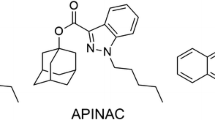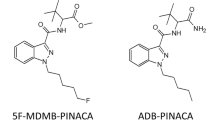Abstract
Purpose
New generations of synthetic cannabinoids (SCs) have recognized strong psychoactive effects, rapidly becoming potent drugs of abuse. Characterization of metabolites associated with SCs is useful for their subsequent detection in biological samples. We aimed to investigate the metabolism of 5F-APINAC, a novel SC, in human liver microsomes (HLMs) (in vitro) and in a rat model (in vivo).
Methods
For the in vitro study, the standard solution of 5F-APINAC was incubated with HLMs for 1 h at 37 °C. In the in vivo study, rats received 15 mg/kg of 5F-APINAC diluted in ethanol or in dimethyl sulfoxide, while a vehicle control group received placebo. Urine was collected 3, 6, and 24 h after administration. The metabolic characterization was performed using liquid chromatography–ion trap mass spectrometry and liquid chromatography–quadrupole time-of-flight mass spectrometry.
Results
In total, 15 metabolites associated with 5F-APINAC were tentatively identified. The metabolites were classified as: 1-adamantol metabolites, oxidative defluorination metabolites, and N-fluoropentylindazole-3-carboxylic acid metabolites. The modifications included ester hydrolysis, mono-, di-, and trihydroxylation of adamantyl ring and N-fluoropentylindazole moiety, oxidation (carbonyl formation) of the N-fluoropentyl side chain, oxidative loss of fluorine, and glucuronidation, as well as combinations thereof. The predominant metabolic reaction was ester hydrolysis in both in vitro and in vivo experiments and formation of M9 (5-fluoropentylindazole-3-carboxylic acid). However, the most recommendable metabolites for proving 5F-APINAC consumption in urine were M4.1, M7, and M13. No metabolites were detected in rat’s urine 24 h after drug administration.
Conclusions
The discovered metabolites are proposed to be incorporated into routine screening analytical methods as the urine markers of 5F-APINAC consumption. This is the first report to demonstrate the metabolism of 5F-APINAC to our knowledge.




Similar content being viewed by others
References
Liechti ME (2015) Novel psychoactive substances (designer drugs): overview and pharmacology of modulators of monoamine signalling. Swiss Med Wkly 145:w14043. https://doi.org/10.4414/smw.2015.14043
Dresen S, Ferreirós N, Pütz M, Westphal F, Zimmermann R, Auwärter V (2010) Monitoring of herbal mixtures potentially containing synthetic cannabinoids as psychoactive compounds. J Mass Spectrom 45:1186–1194. https://doi.org/10.1002/jms.1811
Banister SD, Stuart J, Kevin RC, Edington A, Longworth M, Wilkinson SM, Beinat C, Buchanan AS, Hibbs DE, Glass M, Connor M, McGregor IS, Kassiou M (2015) Effects of bioisosteric fluorine in synthetic cannabinoid designer drugs JWH-018, AM-2201, UR-144, XLR-11, PB-22, 5F-PB-22, APICA, and STS-135. ACS Chem Neurosci 8:1445–1458. https://doi.org/10.1021/acschemneuro.5b00107
Znaleziona J, Ginterová P, Petr J, Ondra P, Válka I, Ševčík J, Chrastina J, Maier V (2015) Determination and identification of synthetic cannabinoids and their metabolites in different matrices by modern analytical techniques—a review. Anal Chim Acta 18:11–25. https://doi.org/10.1016/j.aca.2014.12.055
Zawilska JB, Andrzejczak D (2015) Next generation of novel psychoactive substances on the horizon—a complex problem to face. Drug Alcohol Depend 157:1–17. https://doi.org/10.1016/j.drugalcdep.2015.09.030
EMCDDA (2014) European drug report: trends and developments. https://doi.org/10.2810/32306
Musah RA, Domin MA, Walling MA, Shepard JR (2012) Rapid identification of synthetic cannabinoids in herbal samples via direct analysis in real time mass spectrometry. Rapid Commun Mass Spectrom 26:1109–1114. https://doi.org/10.1002/rcm.6205
Diao X, Huestis MA (2017) Approaches, challenges, and advances in metabolism of new synthetic cannabinoids and identification of optimal urinary marker metabolites. Clin Pharmacol Ther 101:239–253. https://doi.org/10.1002/cpt.534
Cohen J, Morrison S, Greenberg J, Saidinejad M (2012) Clinical presentation of intoxication due to synthetic cannabinoids. Pediatrics 129:e1064–e1067. https://doi.org/10.1542/peds.2011-1797
Derungs A, Schwaninger AE, Mansella G, Bingisser R, Kraemer T, Liechti ME (2013) Symptoms, toxicities, and analytical results for a patient after smoking herbs containing the novel synthetic cannabinoid MAM-2201. Forensic Toxicol 31:164–171. https://doi.org/10.1007/s11419-012-0166-1
Hermanns-Clausen M, Kneisel S, Szabo B, Auwärter V (2013) Acute toxicity due to the confirmed consumption of synthetic cannabinoids: clinical and laboratory findings. Addiction 108:534–544. https://doi.org/10.1111/j.1360-0443.2012.04078.x
Carvalho M, Carmo H, Costa VM, Capela JP, Pontes H, Remião F, Carvalho F, de Lourdes Bastos M (2012) Toxicity of amphetamines: an update. Arch Toxicol 86:1167–1231. https://doi.org/10.1007/s00204-012-0815-5
Takematsu M, Hoffman RS, Nelson LS, Schechter JM, Moran JH, Wiener SW (2014) A case of acute cerebral ischemia following inhalation of a synthetic cannabinoid. Clin Toxicol 52:973–975. https://doi.org/10.3109/15563650.2014.958614
Aldlgan AA, Torrance HJ (2016) Bioanalytical methods for the determination of synthetic cannabinoids and metabolites in biological specimens. Trends Analyt Chem 80:444–457. https://doi.org/10.1002/cpt.534
Lee JH, Park HN, Leem T-S, Jeon J-H, Cho S, Lee J, Baek SY (2017) Identification of new synthetic cannabinoid analogue APINAC (adamantan-1-yl 1-pentyl-1H-indazole-3-carboxylate) with other synthetic cannabinoid MDMB (N)-Bz-F in illegal products. Forensic Toxicol 35:45–55. https://doi.org/10.1007/s11419-016-0331-8
Savchuk S, Appolonova S, Pechnikov A, Rizvanova L, Shestakova K, Tagliaro F (2017) In vivo metabolism of the new synthetic cannabinoid APINAC in rats by GC–MS and LC–QTOF-MS. Forensic Toxicol 35:359–368. https://doi.org/10.1007/s11419-017-0364-y
Holm NB, Pedersen AJ, Dalsgaard PW, Linnet K (2015) Metabolites of 5F-AKB-48, a synthetic cannabinoid receptor agonist, identified in human urine and liver microsomal preparations using liquid chromatography high-resolution mass spectrometry. Drug Test Anal 7:199–206. https://doi.org/10.1002/dta.1663
Hwang J, Hwang J, Ganganna B, Song I, Heo MY, Ahn S-H, Lee J (2018) Metabolic and pharmacokinetic characterization of a new synthetic cannabinoid APINAC in rats. Forensic Toxicol 36:88–101. https://doi.org/10.1007/s11419-017-0387-4
Minakata K, Hasegawa K, Nozawa H, Yamagishi I, Saitoh T, Yoshino A, Suzuki M, Kitamoto T, Suzuki O, Watanabe K (2019) Sensitive quantification of BB-22 and its metabolite BB-22 3-carboxyindole, and characterization of new metabolites in authentic urine and/or serum specimens obtained from three individuals by LC–QTRAP-MS/MS and high-resolution LC–Orbitrap-MS/MS. Forensic Toxicol 37:164–173. https://doi.org/10.1007/s11419-018-0448-3
Diao X, Wohlfarth A, Pang S, Scheidweiler KB, Huestis MA (2016) High-resolution mass spectrometry for characterizing the metabolism of synthetic cannabinoid THJ-018 and its 5-fluoro analog THJ-2201 after incubation in human hepatocytes. Clin Chem 62:157–169. https://doi.org/10.1373/clinchem.2015.243535
Vikingsson S, Josefsson M, Gréen H (2015) Identification of AKB-48 and 5F-AKB-48 metabolites in authentic human urine samples using human liver microsomes and time of flight mass spectrometry. J Anal Toxicol 39:426–435. https://doi.org/10.1093/jat/bkv045
Acknowledgements
We appreciate the general input received during the preparation of this article from Professor Helgi Schiöth, Uppsala University, Sweden. This study was funded by Project 5-100 Sechenov University Grant.
Author information
Authors and Affiliations
Corresponding author
Ethics declarations
Conflict of interest
DB and MO are affiliated with the company Bruker Ltd, Moscow, Russia. SAA, CP, KMS, NVM, AB, RMK, PAM, NLB, GM, FT, and SAS have no conflict of interest to declare.
Ethical approval
All animal procedures were approved by the Institutional Animal Care and Ethical Committee of the Research Center for Molecular Diagnostics and Therapy at Sechenov University, Moscow, in accordance with principles of good laboratory practice [OECD Principles on GLP. C (97)186 Final], following the European Union directive principles of laboratory animal care guidelines (2010/63/EU). This article does not contain any studies with human participants performed by any of the authors.
Additional information
Publisher's Note
Springer Nature remains neutral with regard to jurisdictional claims in published maps and institutional affiliations.
Electronic supplementary material
Below is the link to the electronic supplementary material.
Rights and permissions
About this article
Cite this article
Appolonova, S.A., Palacio, C., Shestakova, K.M. et al. In vivo and in vitro metabolism of the novel synthetic cannabinoid 5F-APINAC. Forensic Toxicol 38, 160–171 (2020). https://doi.org/10.1007/s11419-019-00503-z
Received:
Accepted:
Published:
Issue Date:
DOI: https://doi.org/10.1007/s11419-019-00503-z




